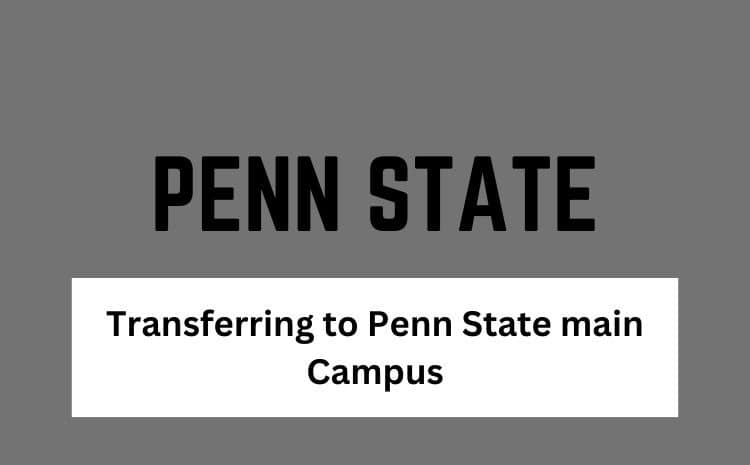
Do you want to transfer to Penn State main Campus and don’t know how to do it? With over 20 campuses across Pennsylvania, the Pennsylvania State University (Penn State) system provides extensive educational opportunities throughout the Commonwealth.
Penn state main campus is the University Park campus and its remains the most prestigious location, boasting top-ranked programs that attract transfer applicants each year.
This article aims to inform prospective transfers on “transferring to Penn State main campus” through an in-depth exploration of the process, requirements, and factors to consider.
Transferring to Penn State Main Campus
Founded in 1855, Penn State’s University Park campus enrolls over 45,000 students and occupies a sprawling arboretum in State College, PA.
Home to highly ranked colleges such as engineering, business, information sciences and more, Penn State’s main campus is an R1 research institution with Division 1 athletics known for school spirit.
While the 24 campuses throughout Pennsylvania offer valuable specialized associate’s degrees, Penn State University Park is viewed as the premier education destination with top faculty and amenities befitting the system’s flagship location.
As such, many students seek transferring to the main campus through the 2+2 program to complete their 4-year Bachelor’s degree.
To gain admittance, transfers undergo an equal rigorous selective screening measuring qualifications compared to freshmen applicants. This article aims to provide insight helping prospective transplants understand requirements while maximizing competitiveness through strategic execution.
Transfer Requirements Explained
The admissions requirements for transferring to Penn State main campus from another institution provide helpful clarity to orient prospective applicants:
- Minimum 24 post-secondary credits completed by start of junior year
- Cumulative GPA >= 3.2/4.0 across all previous colleges
- Completion of general education/Core courses prerequisite to chosen major
- Official transcripts from all institutions ever attended
- Transfer application essays indicating Penn State program fit and ambitions
Meeting criteria through diligent college performance is a minimum prerequisite. However, competitive transfers often surpass them through standout extracurricular engagement as well. But beyond requirements alone, how do transfer statistics provide useful context?
Transfer Acceptance Rate Analysis
To gain perspective on chances, reviewing historical transfer admissions data at Penn State’s main campus yields the following insights:
- Overall transfer acceptance rate: Roughly 45-55%
- Rate for in-state Pennsylvania residents: Slightly higher at 50-60%
- Rate for nursing, engineering majors : Lower 30-45% due to capped seats
- Rate for business, information sciences: Competitive 40-50% range
While reasonable compared to freshman admittance rates nationally averaging 20-30%, these figures indicate a rigorous evaluation process still occurs for applicants from all backgrounds. Understanding contributing admission factors empowers prospective transfers.
Maximizing Your Transfer Competitiveness
Analyzing accepted transfer profiles reveals several differentiated elements within candidates’ control to bolster competitiveness:
- Maintain exemplary minimum 3.5+ cumulative GPA for guaranteed admission screening.
- Complete Core/general education courses early avoiding repetition risk if denied entry.
- Supplement academics with robust leadership roles demonstrating initiative.
- Pursue distinguishing experiences like undergraduate research, study abroad.
- Craft compelling transfer essays speaking to Penn State program fit passionately.
- Ask professors/employers to provide recommendation letters articulating character strengths.
- Visit campus for informational sessions or tours communicating clear campus fit.
Addressing all applicable factors displays preparedness benefiting evaluation. Combined with maintaining model academics, highly motivated transfers position themselves favorably.
Additional Transfer Considerations
Beyond requirements and acceptance statistics, further prudent factors merit due consideration from prospective transplants:
- Investigate comparable universities’ rates as backup options if competition proves daunting.
- Confirm course credits will directly fulfill bachelor’s degree program prerequisites.
- Research campus housing/meal plan, transportation/parking logistics and associated costs.
- Learn transfer scholarship availability and independent grant/loan options available.
- Network through Penn State alumni and transfer coaches to gain insider perspective.
- Prepare for culture shift transitioning between institutions’ communities and expectations.
Weighing all facets relating to program fit, finances and campus acclimation optimizes informed decision making on prospective transfer pathways.
Succeeding as a Penn State Transfer
While acceptance marks the first milestone, seamless success as a new Nittany Lion demands continued strategic execution:
- Connect through transfer peer mentors for campus navigation/social support resources.
- Schedule degree completion plan meetings ensuring credits fulfill requirements on time.
- Join student organizations leveraging previous leadership roles while gaining new experiences.
- Utilize academic and career advising services maximizing post-graduate preparation resources.
- Maintain robust work ethic with elevated expectations adjusting to rigors of flagship university setting.
- Advocate self-confidence amidst change representing transfer student perspectives positively.
Establishing committed continuation earns prestigious alumni designation and new lifelong Penn State network riches.
Conclusion on Transferring to Penn State main campus
In summarizing the topic of “transferring to Penn State main campus,” diligent research finds admissions demanding despite reasonable acceptance rates. Top-caliber interested applicants increase competitiveness through comprehensively addressing profile, essay, and extracurricular factors establishing exemplary fits.
Admitted transfers achieve further success integrating through strategic campus engagement reinforcing community value.
While challenging transfers prove a worthy academic endeavor, highly motivated candidates optimally positioned comprehend requirements and craft contingency plans maximizing all educational opportunities.
Penn State’s flagship campus remains accessible to qualified scholars committed to supplemental excellence.
Leave a Reply